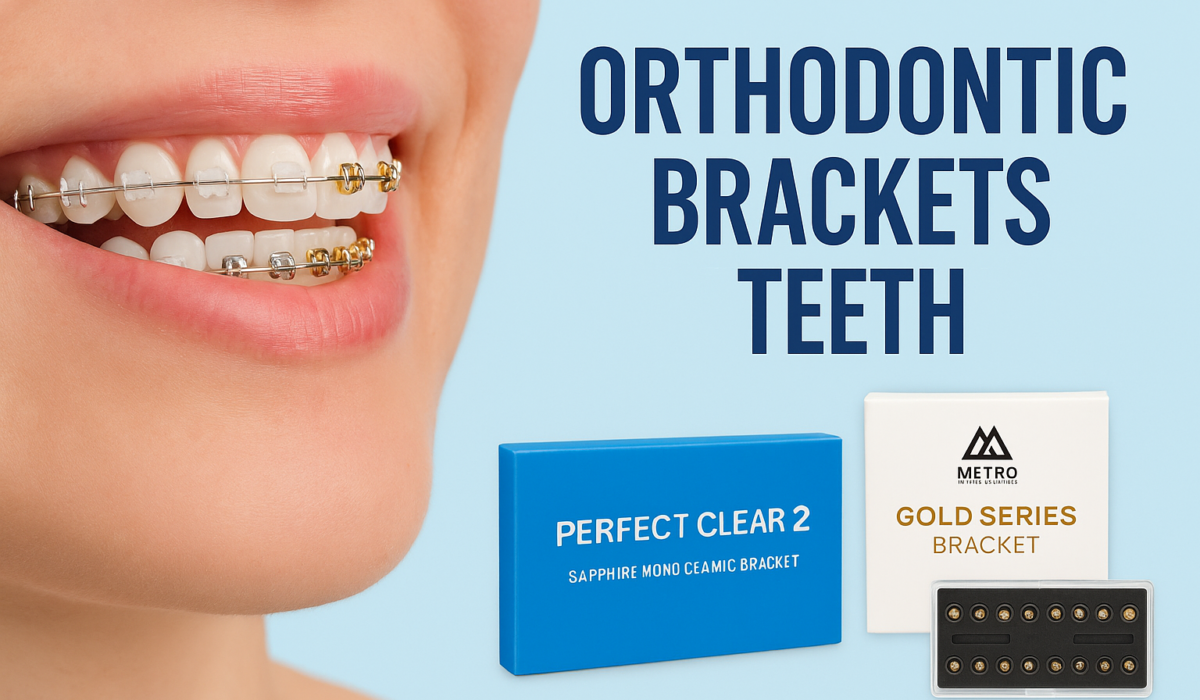
Brackets Teeth 101: Choosing the Best Orthodontic Brackets
Brackets teeth are the tiny engine rooms that drive modern orthodontics. Whether you choose clear ceramic, classic metal or sleek gold, the right bracket turns gentle wire pressure into precise tooth movement.
Below you’ll find everything you need to know—how brackets attach, why they differ, how they affect daily life, and which Dentohook products give the best blend of strength and style.
1. What Exactly Are “Brackets Teeth”?
When people say brackets teeth, they usually mean the small bonded fixtures on the front (or back) of each tooth. A bracket acts as a handle: the orthodontic wire clips into its slot, and tiny elastics or self-ligating gates hold the wire in place. Together they steer teeth into alignment across weeks and months of controlled force. Every bracket is a marvel of micro-engineering—angles, slot size and tie-wing shape all dictate how effectively torque, tip and rotation are delivered.
2. Core Materials: Ceramic vs. Metal vs. Gold
Ceramic brackets give the most discreet look. The Osstem Perfect Clear 2 Sapphire Mono Ceramic Bracket blends with the tooth surface so well that casual onlookers might miss the appliance entirely.
Made from monocrystalline sapphire, this bracket resists staining and delivers steady forces without bulky tie-wings.
Traditional stainless-steel brackets remain the workhorse of orthodontics. They are compact, strong, and affordable. But patients seeking an extra dash of style often go for gold-plated steel. The Metro Orthodontics Gold Series Brackets couple the reliability of steel with a subtle gold finish that looks elegant
rather than clinical.
Gold plating also resists corrosion and can feel slightly smoother against the inner lip.
3. Prescription Matters: MBT, Roth and Damon
When choosing brackets teeth, material is only half the puzzle; the built-in prescription matters too. A Roth set has different tip and torque angles compared with MBT. Passive Damon-compatible brackets use clip gates rather than elastomeric ties, reducing friction and hygiene challenges.
Always confirm with your orthodontist which prescription best suits your bite. Most brands on Dentohook list both .018″ and .022″ slot sizes so you can match existing archwire sets without fuss.
4. Comfort & Hygiene Tips for New Wearers
- Wax is your friend. New brackets teeth can rub lips; a pea-sized wax blob eases irritations in hours.
- Angle your brush. Sweep bristles 45° under the tie-wings—plaque hides there first.
- Floss with a threader. Standard floss won’t pass the wire. A cheap threader keeps gums healthy.
- Switch to low-sugar drinks. Fizzy acids attack enamel around bracket edges faster than you think.
5. Accessory Gear That Works With All Brackets
For the smoothest journey, pair your brackets teeth with quality supporting gear:
- NiTi Archwires for gentle, consistent forces.
- Tooth-coloured elastics to stay almost invisible during social events.
- Light-cure bonding adhesive for strong, moisture-tolerant bonds.
6. Treatment Time: Does Bracket Choice Speed Results?
Research shows average comprehensive treatment lasts 18–24 months, yet the specific brackets teeth you select can swing that timeline by several months. Low-friction ceramic systems may need slightly lighter forces, extending early aligning phases.
Conversely, highly polished stainless or gold brackets let archwires slide easily, cutting binding in crowded arches. Ask your orthodontist for realistic forecasts—and remember that patient discipline (elastic wear, hygiene, breakage) often matters more than bracket brand.
7. Aesthetics vs. Durability: Find Your Sweet Spot
If camera-ready smiles matter, sapphire ceramic is unbeatable. But if you play contact sport or chew hard snacks, metal brackets teeth win for toughness.
Hybrid systems—ceramic on upper front six, metal on the rest—let you hide brackets in the smile zone while keeping strength in high-force areas. Dentohook stocks mixed kits so clinicians can tailor per arch.
8. FAQ Corner
Q 1: Will brackets teeth stain?
Ceramic itself resists stains, but clear elastomeric ties can yellow. Changing ties every 4–6 weeks keeps brackets clear.
Q 2: Are gold brackets hypoallergenic?
Gold plating covers nickel, so most nickel-sensitive patients do fine. If you have severe metal allergy, consider fully ceramic brackets.
Q 3: Can I whiten during treatment?
Not recommended—the covered enamel under each bracket will stay darker, leaving uneven colour. Wait until debonding.
9. Where to Buy Authentic Brackets Online
Avoid generic auction sites; strength and slot accuracy vary wildly. Dentohook is an authorised dental supplier with GST invoices and quick shipping.
Browse their full brackets collection here to compare ceramic, metal and self-ligating options in one place.
10. Final Takeaway
Choosing the right brackets teeth is a balance of look, feel, cost and treatment speed.
Clear sapphire brackets blend quietly with enamel; gold-toned steel adds a touch of luxury; classic stainless keeps budgets low. Whichever route you pick, pair quality brackets with disciplined wear and regular check-ups and you’ll enjoy straight, healthy teeth for life.
Ready to take the next step? Click the links above or explore Dentohook’s full orthodontic range today, and move closer to the confident smile you’ve always wanted.